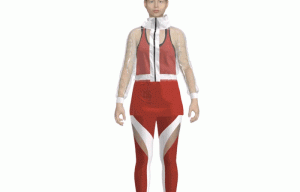
Hohenstein introduces Digital Fitting Lab
New fitting tests designed to address the challenges faced by the ready-made-clothes manufacturers and their customers have paid off, according to Stephanie Müller, expert for fitting tests at the Hohenstein Institute.

27th May 2013
Innovation in Textiles
|
Boennigheim
New fitting tests designed to address the challenges faced by the ready-made-clothes manufacturers and their customers have paid off, according to Stephanie Müller, expert for fitting tests at the Hohenstein Institute.
A number of online retailers and discounters having to deal with customer dissatisfaction finally appear to have found a solution for their problems.

‘People rather than dummies,’ is what Stephanie believes to be the only way to put an end to fitting problems and increase customer satisfaction.
Despite the new body measurement tables produced by the German serial measurement campaign SizeGERMANY and the 3D dummies, most German clothes production companies are still finding it difficult to ensure proper fit for their garments.
A return rate higher than 20 per cent and a large number of complaints from customers struggling to find clothes that would fit are showing how this problem affects businesses on a daily basis. Stephanie Müller believes she knows exactly where the problem lies: ‘In reality, whether someone perceives a garment to have a proper fit depends on how it looks and feels on their body.’

One of the factors missed out by the producers of the body measurement tables appear to be the changes influenced by age: ‘Clothes for 60-year-old women therefore have to be designed differently to those for 18-year-olds – even if these women have the same primary body measurements or dress sizes! Clothing design should take the age-related changes into account accordingly,’ the Institute concludes.
One of the very specific problems faced by the manufacturers, the Institute reports, is the designing of the pus-size fashion, as it also requires the changing of proportions to be taken into account so it offers perfect fit across all sizes.
‘The creation of patterns and the resulting ready-wear measurements alone do not provide any evaluation of proper fit. Neither does comparing garment measurements to the values from ready-wear measurement tables allow any judgement of how good the fit is for the intended target group.’
Fitting tests ‘Made by Hohenstein’ were carried out on the test group of about 250 people of different age and body types.

‘Their body measurements correspond to the age values for the target group and to the data for the dress size to be tested or for the described body contours. This allows fashion for 60-year-olds or plus-sizes to actually be worn by test subjects with the corresponding age or the defined body type.’
Stephanie Müller commented on what she refers to as a certain success: ‘In some cases we were able to reduce the number of complaints due to fitting problems by 50 per cent. The costs for the tests paid off within a very short period of time – and the controllers in the companies were very enthusiastic about this return on investment (ROI).’

Working with manufacturers on the more accurate body measurement tables enables Stephanie and her team to help companies to create a loyal and satisfied customer base, ‘who can buy their entire wardrobe from one brand almost ‘blindly’’.

Business intelligence for the fibre, textiles and apparel industries: technologies, innovations, markets, investments, trade policy, sourcing, strategy...
Find out more